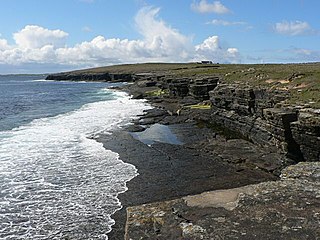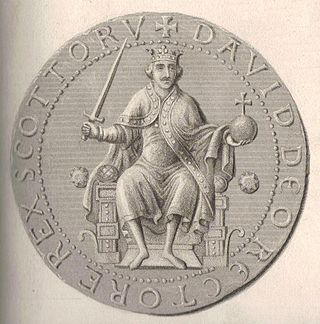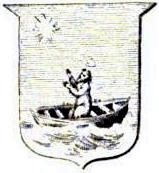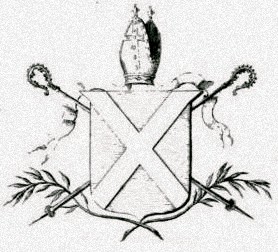
Orkney, also known as the Orkney Islands, is an archipelago in the Northern Isles of Scotland, situated off the north coast of the island of Great Britain. Orkney is 10 miles (16 km) north of the coast of Caithness and has about 70 islands, of which 20 are inhabited. The largest island, the Mainland, has an area of 523 square kilometres (202 sq mi), making it the sixth-largest Scottish island and the tenth-largest island in the British Isles. Orkney's largest settlement, and also its administrative centre, is Kirkwall.

Stronsay is an island in Orkney, Scotland. It is known as Orkney's 'Island of Bays', owing to an irregular shape with miles of coastline, with three large bays separated by two isthmuses: St Catherine's Bay to the west, the Bay of Holland to the south and Mill Bay to the east. Stronsay is 3,275 hectares in area, and 44 metres in altitude at its highest point. It has a usually resident population of 349. The main village is Whitehall, home to a heritage centre.

Papa Westray, also known as Papay, is one of the Orkney Islands in Scotland, United Kingdom. The fertile soil has long been a draw to the island.
The Bishop of Aberdeen was the ecclesiastical head of the Diocese of Aberdeen, one of Scotland's 13 medieval bishoprics, whose first recorded bishop is an early 12th-century cleric named Nechtan. It appears that the episcopal seat had previously been at Mortlach (Mòrthlach), but was moved to Aberdeen during the reign of King David I of Scotland. The names of three bishops of Mortlach are known, the latter two of whom, "Donercius" and "Cormauch" (Cormac), by name only. The Bishop of Aberdeen broke communion with the Roman Catholic Church after the Scottish Reformation. Following the Revolution of 1688, the office was abolished in the Church of Scotland, but continued in the Scottish Episcopal Church. A Roman Catholic Diocese of Aberdeen was recreated in 1878.

The Archbishop of Glasgow is an archiepiscopal title that takes its name after the city of Glasgow in Scotland. The position and title were abolished by the Church of Scotland in 1689; and, in the Scottish Episcopal Church, it is now part of the Episcopal bishopric of Glasgow and Galloway. In the Roman Catholic Church, the title was restored by Pope Leo XIII in 1878.

The Bishop of St. Andrews was the ecclesiastical head of the Diocese of St Andrews in the Catholic Church and then, from 14 August 1472, as Archbishop of St Andrews, the Archdiocese of St Andrews.

The Bishop of Dunblane or Bishop of Strathearn was the ecclesiastical head of the Diocese of Dunblane or Strathearn, one of medieval Scotland's thirteen bishoprics. It was based at Dunblane Cathedral, now a parish church of the Church of Scotland. The bishopric itself certainly derives from an older Gaelic Christian community. According to legend, the Christian community of Dunblane was derived from the mission of St. Bláán, a saint originally associated with the monastery of Cenn Garath (Kingarth) on the Isle of Bute. Although the bishopric had its origins in the 1150s or before, the cathedral was not built nor was the seat (cathedra) of the diocese fixed at Dunblane until the episcopate of Clement.
John D. Mackay was a Scottish schoolteacher. He taught on Stronsay and North Ronaldsay before working as headmaster of Sanday School between 1946 and 1970.

Orkney Ferries is a Scottish company operating inter-island ferry services in the Orkney Islands. The company operates ferry services across 15 islands.

Historical treatment of David I and the Scottish church usually emphasises King David I of Scotland's pioneering role as the instrument of diocesan reorganisation and Norman penetration, beginning with the bishopric of Glasgow while David was Prince of the Cumbrians, and continuing further north after David acceded to the throne of Scotland. As well as this and his monastic patronage, focus too is usually given to his role as the defender of the Scottish church's independence from claims of overlordship by the Archbishop of York and the Archbishop of Canterbury.
George Haliburton was a Scottish cleric and Jacobite. He was both Bishop of Aberdeen and Chancellor of King's College, Aberdeen.

The Diocese of the Isles, also known as the Diocese of Suðreyar, or the Diocese of Sodor, was one of the dioceses of medieval Norway. After the mid-13th-century Treaty of Perth, the diocese was accounted as one of the 13 dioceses of Scotland. The original seat of the bishopric appears to have been at Peel, on St Patrick's Isle, where indeed it continued to be under English overlordship; the Bishopric of the Isles as it was after the split was relocated to the north, firstly to Snizort and then Iona.

The Archdiocese of St Andrews was a territorial episcopal jurisdiction of the Catholic Church in early modern and medieval Scotland. It was the largest, most populous and wealthiest diocese of the medieval Scottish Catholic church, with territory in eastern Scotland stretching from Berwickshire and the Anglo-Scottish border to Aberdeenshire.

Kirkwall Grammar School is a secondary school in Kirkwall, Orkney, Scotland. It was established in c. 1200. The current school building was opened in 2014. It is the largest school in the Orkney Islands.












